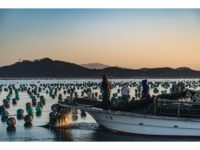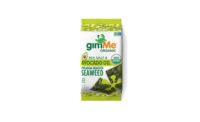As awareness continues to rise around climate change, interest in sustainable farming practices and usage of coastal and marine resources has increased. Brands across all industries are exploring the various ways seaweed can be used in products.
Seaweed is the ultimate regenerative crop, and along with shellfish, one of the few farmed foods with a net positive environmental impact. It requires no fresh water to grow, and if farmed organically without the use of pesticides and chemicals can help to keep our oceans clean and fight climate change.
Last year Whole Foods even predicted water conservation and regenerative agriculture would be trending in food and beverage in 2024.
Gimme Seaweed is exemplifying the seaweed movement in the food industry and beyond. It was the first and current leading seaweed snack brand in the U.S., and it has embarked on a mission to unlock seaweed’s potential to fight climate change. Organic seaweed farms like Gimme’s sequester carbon and improve water quality. 1 ton of seaweed can sequester over 1 ton of CO2 per year. In 2022 Gimme introduced a Grab & Go line without plastic trays, in another demonstration of the brand’s commitment to sustainability.
To find out more about the brand's commitment to sustainability, we sat down with Diego Norris, CMO, Gimme Seaweed.
Liz Parker: How has interest in sustainable farming practices and usage of coastal and marine resources increased, in terms of seaweed?
Diego Norris: As awareness of climate change and its impact on the environment continues to rise, we've observed a sharp increase in consumer demand for seaweed. This has led coastal communities with the right conditions for seaweed production—such as the Northeast coast of the U.S.—to capitalize on this emerging opportunity. Seaweed farming aligns perfectly with the natural rhythms of the region, complementing the traditional fishing seasons for crab and lobster. This synergy not only provides a stable, year-round economic opportunity for these communities but also promotes sustainable practices that contribute to the health of our marine ecosystems.
LP: How can seaweed be used in products?
DN: Seaweed is a vegetable and a superfood that tastes unlike any other green. It is also the most nutrient-dense vegetable on the planet, and requires no fresh water, land, or chemicals to grow. Our founders recognized an opportunity to adapt a traditional Korean snack for an American audience. Their vision led to the creation of the world’s first USDA Certified Organic, Non-GMO Project Verified seaweed snacks. We harvest seaweed at the peak of flavor to ensure the sweetest, more umami-packed taste and roast it to light and crispy perfection. Our snacks are paired with our favorite hand-selected seasonings for the best taste.
LP: How can seaweed show a net positive environmental impact? And how can it be farmed organically?
DN: Seaweed is considered a zero-input food because it requires no land, fresh water, or chemicals to grow. Instead of growing veggies in the soil, we grow our veggies in the ocean. When grown organically, the way Gimme grows all of its seaweed, the sun and the sea provide everything it needs to thrive.
Seaweed has also been proven to reduce methane gas and has the potential to replace fossil fuels. Plus, marine algae produce 50-80% of the world’s oxygen and absorbs huge amounts of carbon dioxide from the Earth’s atmosphere.
LP: Can you talk about Gimme’s organic seaweed farms?
DN: Gimme helped pioneer the first organic seaweed farms in South Korea to bring the first USDA Certified and Non-GMO Project Verified seaweed snacks to the U.S. Organic seaweed farms like Gimme’s sequester carbon and improve water quality. Gimme also has a team of scientists and researchers in Korea ensuring their seaweed is sustainably grown and harvested, without the use of any chemical additives that may be used by conventional seaweed companies.
LP: How does Gimme create its seaweed snacks?
DN: Our seaweed is grown in the protected, nutrient-rich waters of South Korea. We time our harvest for the best possible taste and texture. Seaweed is cut right on the water to capture that sweeter, umami-packed taste and the "al dente" texture Gimme’s famous for. Gimme Seaweed goes through two rounds of roasting: first to dry the seaweed, and again after being brushed with organic oils. Each piece of seaweed is then seasoned and flavored with our custom seasoning blends before it is cut into sheets.
LP: Can you talk about the brand’s Grab & Go line, which does not use plastic trays?
DN: Back in 2020, we were the first to test “trayless” packs to reduce the use of single-use plastic. In 2022, we officially launched the Grab & Go line in three of our top selling flavors: Sea Salt, Avocado Oil, and Teriyaki. This line offers the same nutritious seaweed snacks consumer love, but in a trayless, portable pack that includes an easy-open feature. This was a successful launch for Gimme and we plan to continue to expand the line into more flavors soon.
LP: How else is the brand committed to sustainability?
DN: Gimme’s commitment to sustainability starts in the ocean. Gimme was the first company to offer organic, non-GMO seaweed. The founders, Annie and Steve, worked closely with seaweed farmers in South Korea to develop the standard for Organic, non-GMO seaweed that is widely used today by the industry. Gimme also works in close cooperation with the Korean National Federation of Fisheries Cooperatives to improve and grow the Korean Seaweed industry.
LP: Any new products coming out soon or this year?
DN: Gimme is excited to expand our Roasted Seaweed Snack line with the launch of our new Gochujang Korean BBQ flavor this summer! This new flavor was crafted by our founder, Annie Chun. It’s the perfect blend of spicy, tangy, and sweet.





